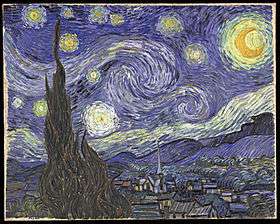Timbres, espace, mouvement
Timbres, espace, mouvement (Timbre, space, movement) is a work for orchestra, composed by Henri Dutilleux, in 1978. It is subtitled La nuit etoilée (The Starry Night), in reference to the painting by Vincent Van Gogh. The composer wanted to translate, in his composition, the "almost cosmic whirling effect which (the painting) produces".[1]

This work is written for: 16 woodwinds (4 flutes, 4 oboes, 4 clarinets, 4 bassoons), 11 brass instruments (4 horns, 3 trumpets, 3 trombones, tuba), 12 celli, 10 double basses, percussion, harp, celesta, and timpani; there are no violins or violas. Their absence was meant to translate the impression of relative emptiness and immobility conveyed by the lower half of the painting. On the other hand, the wind instruments and percussions are particularly prominent. Their solos represent the movements of the clouds and the light of the stars and the moon. Space is represented by an unusual distribution of the celli. They are placed at the foreground, in a half circle around the conductor. The movement is symbolized by the alternation of static episodes and whirling solos.
The work was commissioned by Mstislav Rostropovich, who gave the premiere with Washington National Symphony Orchestra on 7th, November 1978. The piece is dedicated to Charles Münch. A 1991 revision added an interlude, intended for the cellos alone.
It comprises two movements, separated by an interlude played by the cellos. Its execution requires approximately fifteen minutes.
References
- Henri Dutilleux: His Life and Works, Caroline Potter ISBN 1-85928-330-6
- Henri Dutilleux:Timbres, espace, mouvement on max-texier.ircam.fr
- Dutilleux, Henri at The Living Composers Project Contains information on orchestral composition
Notes
- ↑ French,"effet de tournoiement quasi cosmique qui s'en dégage" – Dutilleux.
| ||||||||||||||||||||||||||||||